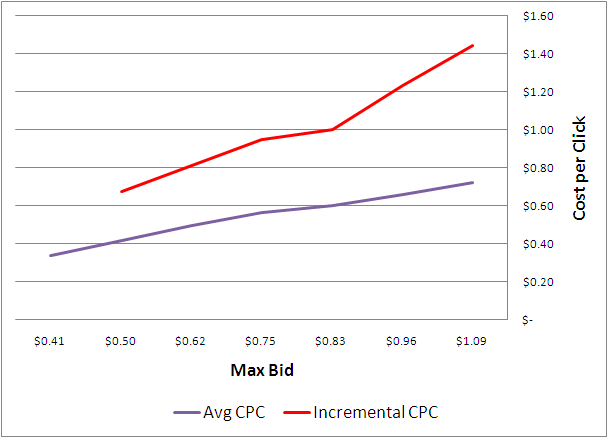Paid Search: The Bright-Line Divide
There are plenty of good reasons to advertise on your brand name. Advertising on your brand allows you to: Control the message. The text of the message can be kept fresh, highlighting promotions, shipping cut-off dates, whatever makes sense for the brand. Direct traffic. Site-links provide an opportunity for users to navigate to the next […]
There are plenty of good reasons to advertise on your brand name.
Advertising on your brand allows you to:
- Control the message. The text of the message can be kept fresh, highlighting promotions, shipping cut-off dates, whatever makes sense for the brand.
- Direct traffic. Site-links provide an opportunity for users to navigate to the next page deeper rather than just the home page, thereby aiding conversions.
- Occupy real estate. Taking up more space on the SERP means less leakage to affiliates and competitors.
- Capture incremental traffic. In some cases, our research shows that paid search ads on brand names do indeed bring in some incremental traffic. Your mileage will vary, so test this yourself, but in some instances the advertising more than pays for itself without any other considerations.
However, the fact that it is generally wise to advertise on one’s trademark doesn’t change another crucial principal of paid search marketing:
Never, never, never mix the results of brand advertising with competitive non-brand advertising.
All averages lie. Blending the results of brand and non-brand search doesn’t just lie, it will kick you in the teeth and take your lunch money, too.
Mixing the results of brand and non-brand paid search results leads to a false sense of scale and efficiency for the program which in turn creates chronic problems down the line.
The greater the fraction of overall “paid search” sales brand ads represent the greater these problems become.
Problem 1: Lack of Control
The core problem is that the paid search manager has very little control over the volume of traffic, the conversion rates, or even the cost of brand advertising. The paid search manager can and should test and adjust copy for maximum positive effect.
He or she can and should make sure site links and seller ratings are used to full advantage. S/he can and should test landing page versions and messaging to wring the most successful visits out of brand search traffic.
Assuming the good paid search manager has done these basics, they’ve exercised about all the control they have over brand search performance.
Other than guarding against some crazy CPC penalties Sid Shah and we have seen, the ads will serve at the top of the page for most folks at low cpcs and there won’t be any leverage to get more.
Traffic and conversion volume on brand search will rise and fall largely, if not entirely, as a result of offline marketing, brand awareness, friend referrals, and loyal customers navigating to your doorstep; the paid search manager controls none of those factors.
We’ve seen brand sales account for anywhere between almost nothing for internet pure-plays in start up mode, to over 90% of overall sales for very well established brands with huge offline advertising budgets.
Evaluating the performance of a paid search program by looking at overall numbers, when 70 – 90% of the conversions are on your brand, is ludicrous. You end up being praised or scolded based on factors entirely outside of your control.
Competent people want to be evaluated based on what they control, and in search that’s the performance of competitive non-brand keywords.
Problem 2: Disconnect Between Average Efficiency & Incremental efficiency
We’ve long preached the importance of understanding more than just the average ROI of your paid search efforts, but also the incremental efficiency of the last dollar spent.
Predicated on the notion of Diminishing Marginal Returns, smart marketers will always get more ROI from the first dollar of advertising than the last dollar of advertising, because s/he always picks the lowest hanging fruit available.
Understanding the incremental ROI will let you predict what the next chunk of ad spend is likely to generate.
Because of Diminishing Marginal Returns the incremental ROI is always worse than the average ROI — if it isn’t you’re doing something wrong. Our studies of Bid Simulator data find that within competitive non-brand paid search the incremental ROI is usually on the order of 60% – 80% of the average ROI.
Your average non-brand ROI may be 5 to 1, but additional spend over that same period is likely to be at 4 to 1 or 3 to 1, which may be under water for your business.
However, that disconnect pales in comparison to the disconnect between the two when the average includes brand sales.
We see instances where an advertiser sees an “average ROI” (including brand sales) of 8 to 1, where the competitive non-brand average ROI is 1 to 1, and the incremental ROI is significantly worse than that.
The brand may say: “We’re comfortable letting the overall ROI drop to 7 to 1 for now” but oftentimes they don’t seem to realize that they’re feeding money into a shredder at that point.
Let’s think about a 1 to 1 ROI. You spend a dollar in advertising to drive a dollar in sales. It would be just as efficient to have your paid search manager place orders on your website using the marketing budget to pay for it…and then throw the merchandise in the trash can when it arrives!!!
The 1 to 1 ROI may make sense for some folks, and that’s cool. The point isn’t that you shouldn’t spend for branding purposes, just that incorporating brand data hides the likely ROI on the next dollar spent.
Problem 3: Complete Misread Of Online To Offline Spillover
Hugely misleading studies, like this one, suggesting that for every dollar generated online by search ads there are $6, $7, I’ve even seen a claim of $10 in sales generated offline, make people believe that they’re spending money cost effectively when they aren’t. Not one of these studies has made the brand non-brand distinction.
Obviously, plenty of people want to find a store locator, the nearest State Farm Agent, business hours, in-store availability of what they’re looking for, etc. before they hop in their car and drive to the store or business.
They search for the brand they’re about to drive to, and you can bet your last dollar that the ad that shows up after they search for you by name isn’t capturing much incremental traffic.
Problem 4: Pulling The Wrong Levers
Because the misunderstanding of advertising efficiency is SO profound companies compound their problems by taking money out of other offline channels to pour more money into search because it seems so much more efficient.
“We’re getting an 8 to 1 ROI from paid search and only 2 to 1 from catalog prospecting; let’s dump the catalog and put the money into search.”
I’ve seen this happen more than once with budgets for catalogs, infomercials, circulars, TV ads, etc slashed to put more into search.
Sometimes that’s the right call, but often it’s based on the fundamental misunderstanding we’re describing and it leads to a death spiral.
The advertiser presents us with more money to spend in search and says: “we need sales to grow by 50% to cover the loss of the other marketing efforts”, and frequently paid search sales go nowhere or even decline because the advertising that was driving the brand search was cut off.
Problem 5: Inevitable Disappointment
As a result of the first four problems, the advertiser will invariably end up disappointed with their paid search manager or agency at some point.
Frustration comes because incremental advertising spend in search is hugely inefficient and this comes as a surprise for some reason.
Or, overall sales goals aren’t met because brand sales sag unexpectedly and the paid search manager has no way to compensate. Or the reckless spending encouraged by the combined view is a symptom of deeper business problems resulting in a trip through Chapter 11.
Or someone else in the organization — a CFO, a CEO, a new search manager — comes in, pulls apart the numbers and is horrified at the wasteful spending in competitive non-brand search that was previously hidden from view.
We’ve seen all of these scenarios play out, despite the fact that we have always encouraged our clients to evaluate performance strictly by the non-brand numbers.
With few exceptions, when goals are expressed in terms of aggregate brand and non-brand performance frustration is inevitable.
Advertisers end up frustrated with the paid search manager for not controlling that which s/he doesn’t control, and the paid search manager with their bosses for not understanding this fundamental disconnect.
The Charlatans Don’t Help
Unfortunately, many agencies, engines and others who feed on online advertising have a vested interest in blurring the brand, non-brand distinction.
These folks exaggerate the complexity of search funnels, buying cycles, and now attribution across channels and encourage advertisers to look at data more ‘holistically’ and with less granularity. That’s garbage!
Advertisers should look at data more intelligently, not throw up their hands and call it holistic marketing.
Intelligent use of data includes attribution of credit within paid search and across channels — as we do — and may include complex media mix studies to gauge optimal advertising spending levels for each program.
There are many valuable ways to look at aggregated data. Performance by category, subcategory, geography, keyword specificity, landing pages, number of ‘tokens’, and other useful classifications can reveal actionable insights.
However, folding in brand results never aids clarity and only causes confusion. While it may, in the short run, make paid search look better than it is, it will invariably make the paid search manager look bad in the long run.
Contributing authors are invited to create content for Search Engine Land and are chosen for their expertise and contribution to the search community. Our contributors work under the oversight of the editorial staff and contributions are checked for quality and relevance to our readers. The opinions they express are their own.
Related stories
New on Search Engine Land





